Germany reached their footballing peak on July 13, 2014, on a magical night in Rio de Janeiro, Brazil.
In the third World Cup final against Argentina, Germany won its fourth title, capping off an amazing six-year span in which it reached at least the semi-finals of every major tournament.
The golden generation of Germany had a multitude of world-class players, headlined by superstars like Mats Hummels, Toni Kroos, Mesut Özil and Thomas Müller, captained by one of Germany’s biggest footballing legends, Philipp Lahm.
While Lahm never was a spectacular player, he was always one of the smartest people in the game.
Making 332 caps for FC Bayern and 113 international caps, the right-back and midfielder impressed with his calm demeanour and incredible football IQ.
He is one of the best right-backs the game has ever seen.
After the 2014 World Cup, Lahm decided to call it quits for the national team and ended his international career at the very top.
Ten years later, Germany is still trying to find a replacement for their former captain.
While Joshua Kimmich can play as a right-back and did so again at Euro 2024, he is more of a midfielder.
Outside of Kimmich, the German coaches have tried the likes of Lukas Klostermann or Jonas Hofmann at right-back, but the nation still craves an actual successor to Lahm.
Fortunately, after 10 long years, the wait might be over.
Over the last couple of years, a young right-back has emerged in Erding, a small town near Lahm’s hometown, Munich.
But unlike his predecessor Lahm, Lukas Reich chose FC Bayern’s arch-rival TSV 1860 Munich and climbed the ranks of their academy and the German youth national teams.
Reich will turn 18 in late October 2024, but he has already established himself as the starting right-back in the German third division for 1860 and has become one of the best right-backs in the league.
It is only a matter of when, not if, Reich will make the next step and play in the Bundesliga and the U21 Team for Germany.
In this scouting report, we will examine what makes the young right-back so talented, where he still needs to improve, and how he is able to play at such a high level at only 17 years of age.
Lukas Reich Data Profile
First, we are going to take a look at the data regarding Lukas Reich.
Remember that Reich did not play at the professional level before the start of this season, which means that available statistics are rare and the sample size is small.
If we look at what right-backs need to be good at, the position has undergone major changes over the last couple of years.
However, every full-back still needs to be good at one thing: defending.
Reich has exclusively played as a right-back in a back four for 1860 this season in 3. Liga, which is definitely his best position overall.
So, if we are talking about Reich, we obviously need to talk about his defensive work first.
Lukas Reich Defensive Duels Chart
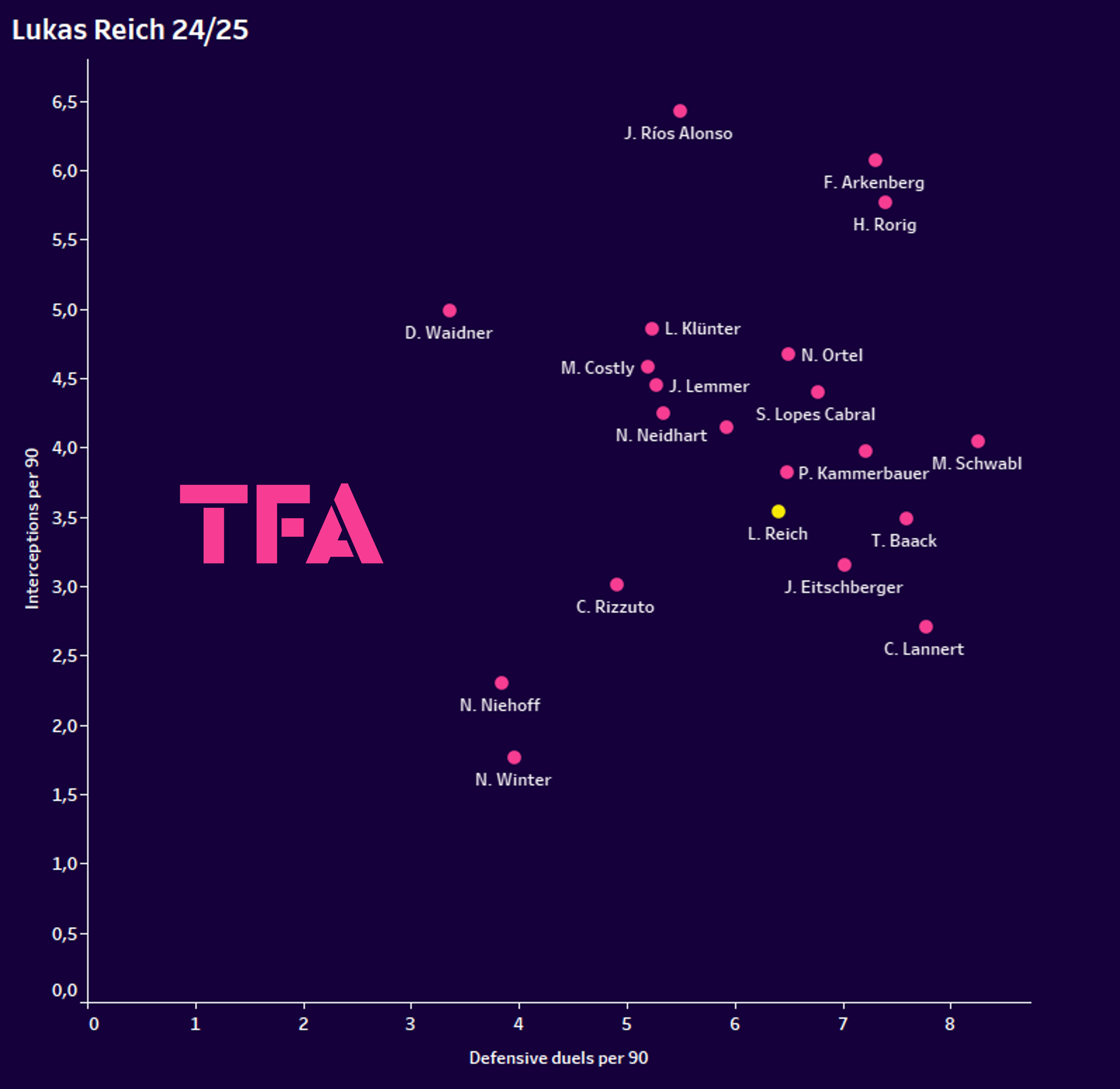
Here, we can see a diagram showing Lukas Reich compared to other right-backs with a minimum of 500 minutes played in 3. Liga in the 2024/25 season so far.
As the graph shows, Reich still has significant work to do on the defensive side.
He is not a complete liability, but he still struggles with his defence right now.
He ranks below average in defensive duels per 90 and interceptions per 90.
While Reich wins a decent amount of his defensive duels, over 65%, he especially struggles in aerial duels, where he ranks in the bottom five regarding the percentage of aerial duels won.
Regarding interceptions, Reich also struggles a fair bit compared to the other qualifying right-backs and barely ranks outside of the bottom five.
However, he is only 17 years old and is playing his first season at the senior level, so he can’t be expected to be a perfect defender yet.
Lukas Reich xA Per 90 Chart
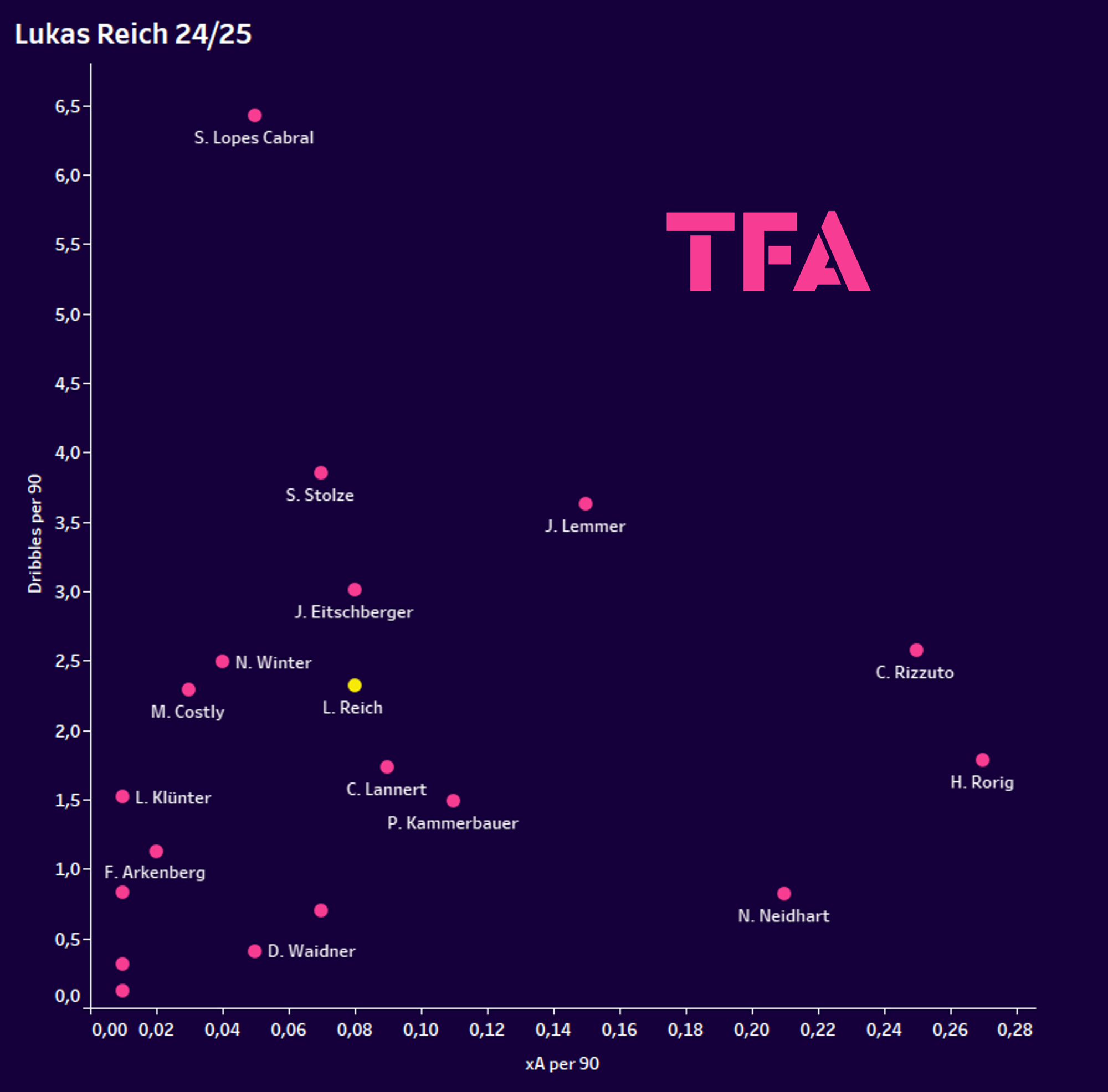
If we look at what Reich does with the ball, things are already looking way better.
In the diagram above, we can see that Reich ranks above average in xA per 90 minutes, meaning that he assists many goalscoring chances compared to the other right-backs with 500 or more minutes of playing time so far this season.
This shows the potential that Reich possesses as a more forward-moving full-back.
Modern full-backs are often also tasked with helping out in attack and being significant parts of the offensive game plan, and Reich looks very promising in this regard.
Also, even though he is very young, he is not afraid of going into attacking 1v1 duels, ranking above average in dribbles per 90 as well.
He also does not just dribble a lot.
His success rate of exactly 50% is very decent for a full-back and shows that he has the ability to create and use opportunities on the attacking side of things.
Lukas Reich Passes Per 90 Chart
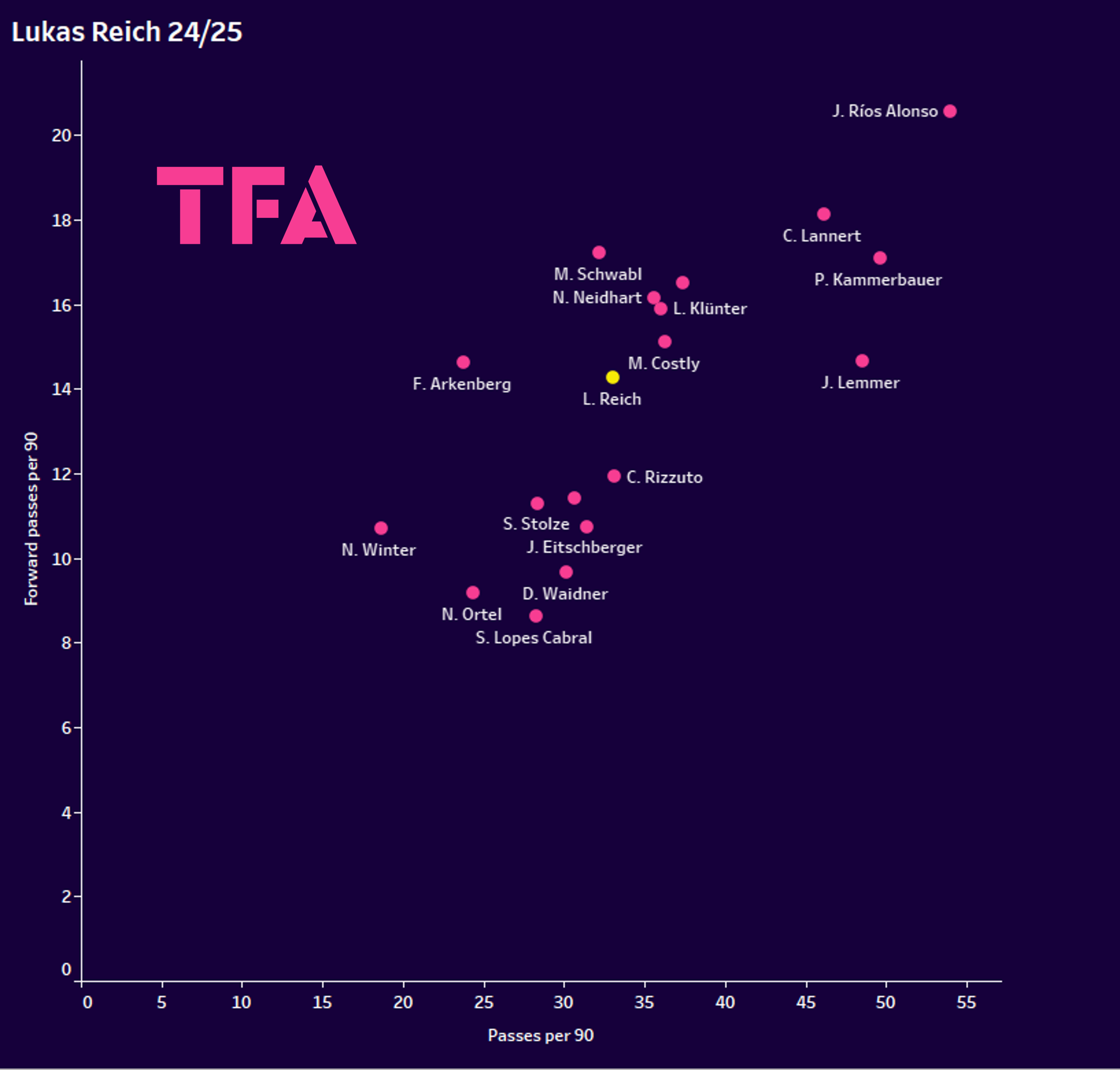
Lastly, we will compare Reich’s passing game performance to that of other right-backs with 500 or more minutes of playing time.
Although TSV 1860 only had 47.4% possession of the ball in their games, Reich still managed to rank slightly above average in passes per 90, showing that he was really involved in the 1860s’ passing game.
He also doesn`t just square the ball a lot; he actively tries to take some responsibility and progress the ball, ranking above average in forward passes per 90 as well.
Reich also has a decent completion percentage of 70% for these forward passing, making him rather successful in these moments.
Overall, the data profile shows a lot of promise with the ball and some room for improvement against the ball, but considering Lukas Reich is only 17 years old, it’s rather impressive how much of an impact he already has on the game.
Lukas Reich In Possession
Now, we will examine Lukas Reich’s style of play under Argirios Giannikis’s tactics when TSV 1860 has possession.
Reich usually plays as the right-back in a 4-2-3-1 formation, which means he has an additional player as a winger in front of him.
Reich usually receives the ball rather wide but not directly next to the sideline.
He then likes to move inward and forward on the right side, carrying the ball forward often when he receives it.
TSV 1860 then likes to drop one player out really wide in their attacking line; most of the time, it is the near-sided winger.
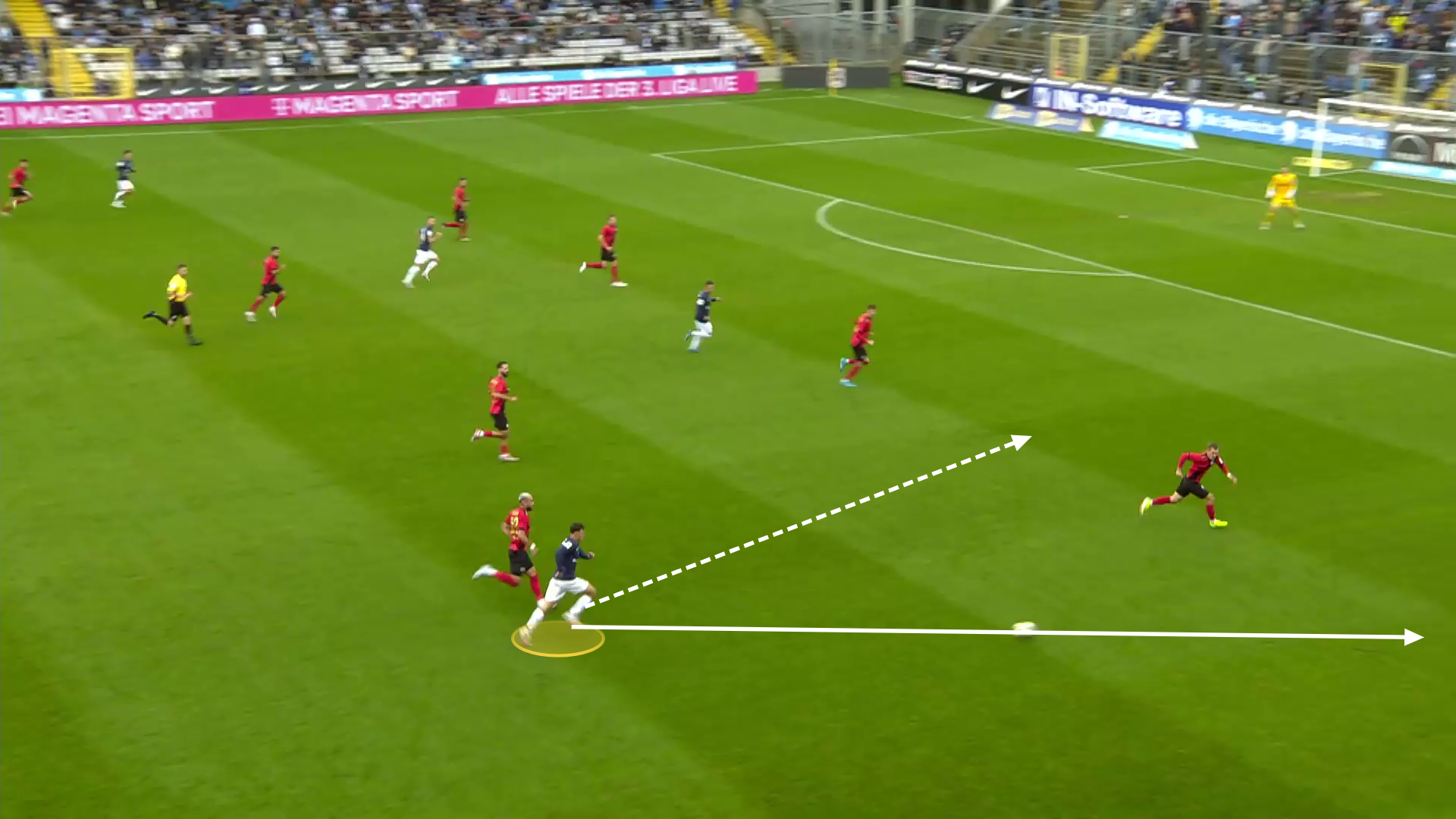
Here, we can see a typical attack situation for Reich: he received the ball and then carried it forward through the entire midfield.
Then, he dribbles onto the opposing team’s defensive line, keeping them compact and focusing on defending in the centre of the pitch.
Reich and 1860 used this to their advantage.
They freed up the right winger near the sideline, where Reich could play an easy pass.
From there on, 1860 tries to play the ball into the box but fails to do so.
Reich instantly positioned himself to receive the ball again, right at the box’s edge.
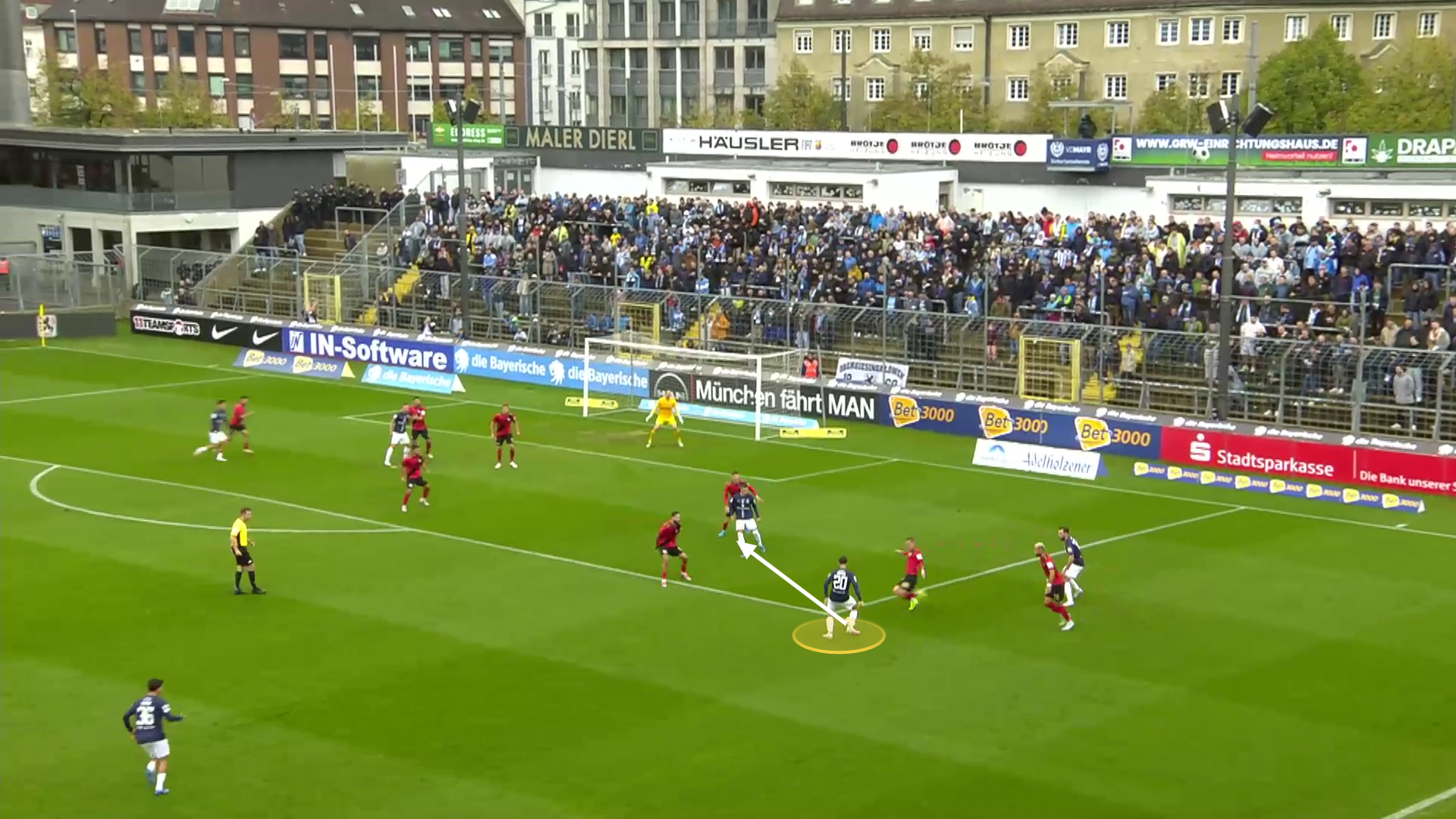
After receiving the ball, Reich instantly scans the box for solutions to progress the ball again.
He then plays a short pass instead of crossing the ball to the far post, opening up more possibilities for link-up play in a condensed space.
Reich always likes to play short passes over crosses.
With just over two crosses per game, Reich is not a full-back with a high volume of crosses.
Ultimately, this situation did not turn into a goalscoring opportunity because Reich’s teammates lost the ball in the box, but it still was an excellent opportunity for the team.
The 1860s approach to the game is rather direct; most build-up scenes and situations are pretty much a copy of what happened here.
The centre-backs play the ball towards Reich, he carries it forward, then plays a pass to the winger, and 1860 loses the ball near the box.
While Reich does well up until the final third, he fairly struggles in his own and in the final third.
His solutions in the final third are often rather bleak and easy to read for more experienced defenders, and Reich still has to adjust to that.
While it was easy for him to find solutions in the passing game, even in the tightest of spaces at the youth level, he needs to be able to accept and adjust to the fact that at the senior level, defenders are simply better, faster, and stronger.
He sometimes needs to brute-force some things instead of always trying to play theoretically perfect football.
1860 also uses Reich as the man out wide, and he does exceptionally well in these positions too.
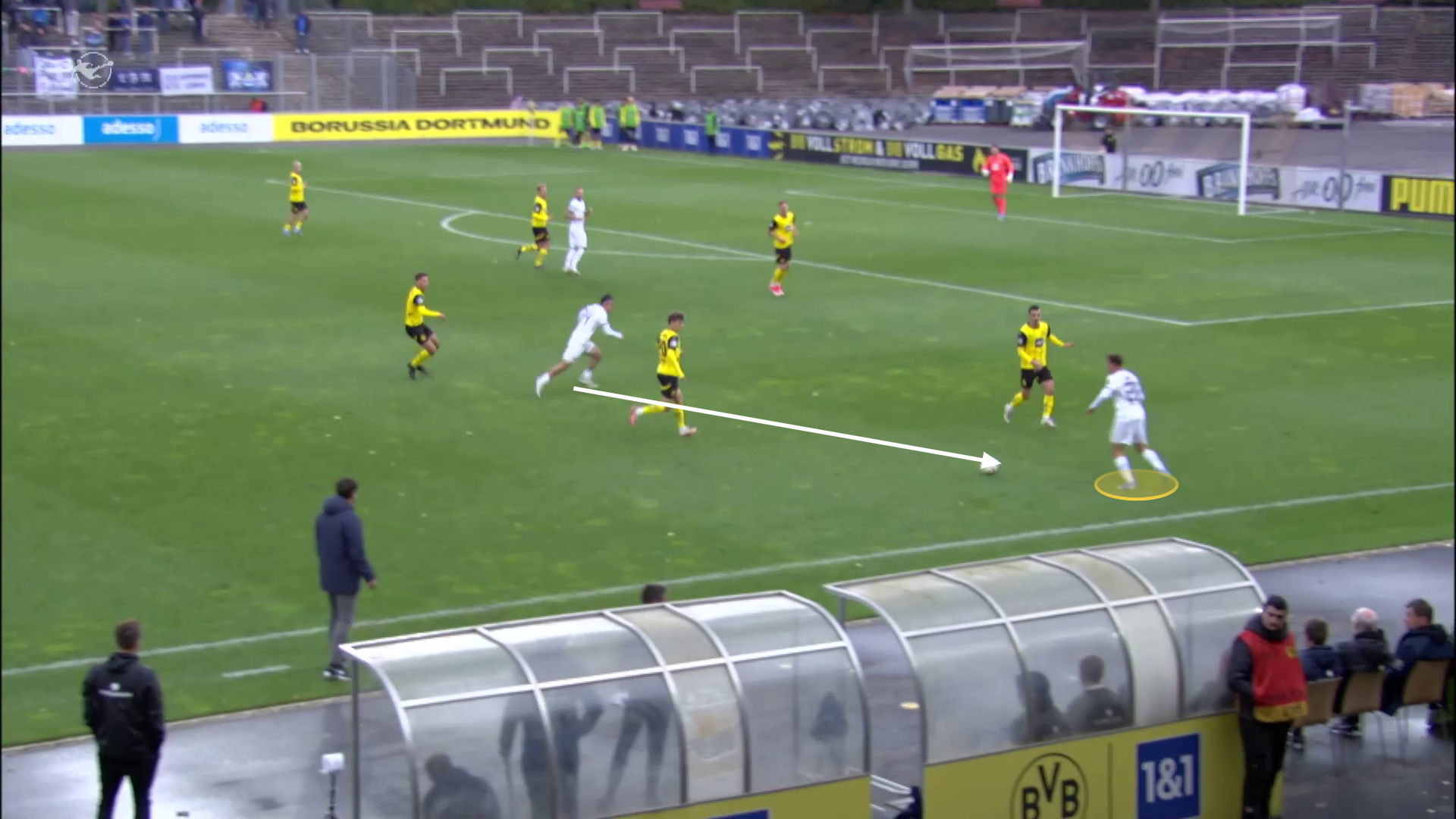
Here, we can see Reich receiving the ball out wide with a defender closing him out.
He instantly scans the field and his teammates’ movements and tries to find a quick solution.
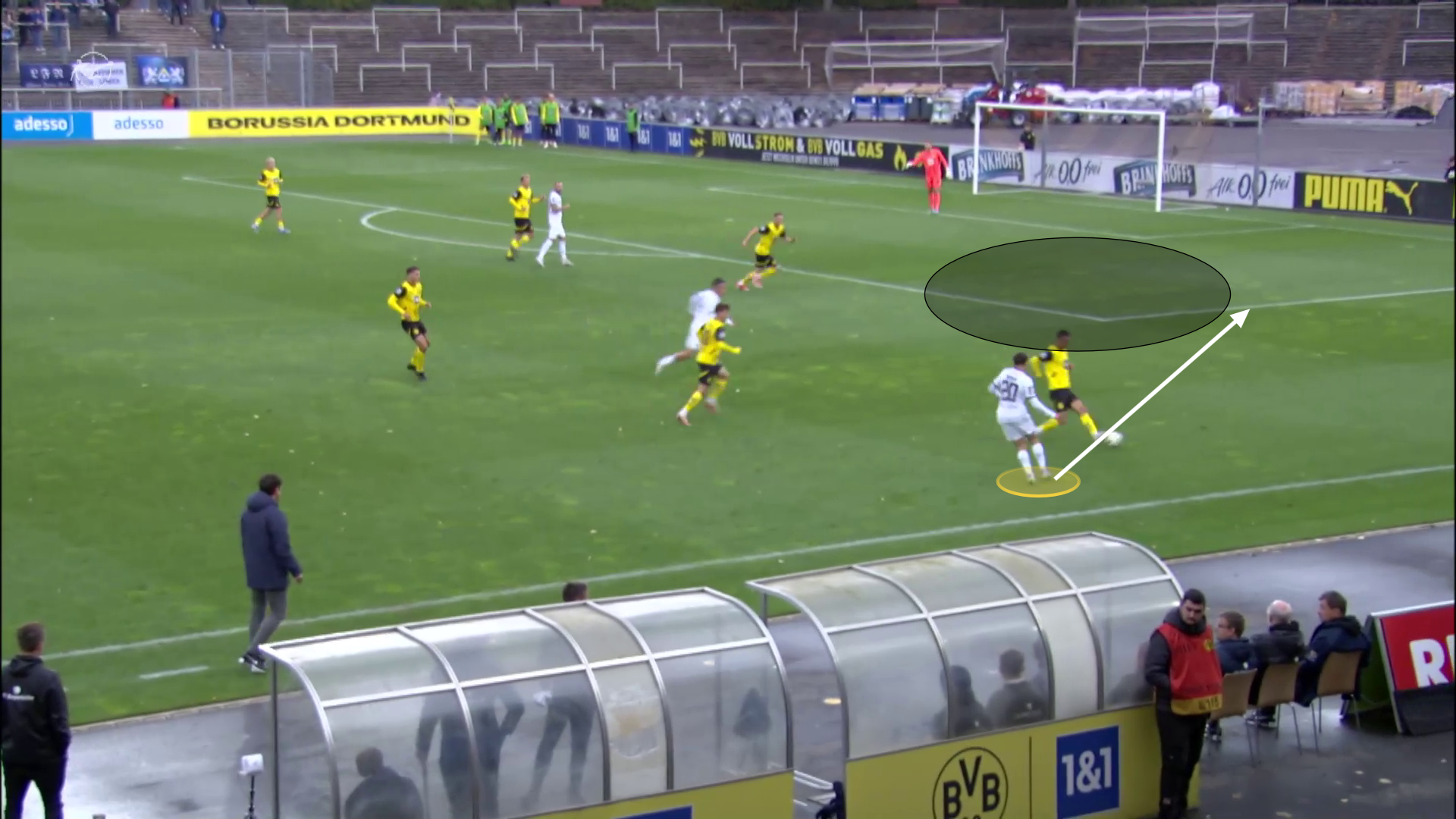
He recognises the space behind the opposing left-back very well and quickly picks up on his teammate’s run instantly.
He plays a one-time pass into that space, but because that is pretty much all 1860 does, the Dortmund defender completely gambles on Reich playing that pass and is able to deflect it with his tippy-toes.
This situation still shows that Reich is incredibly quick on his feet and in his head, able to make snap decisions, and able to link up with his teammates in different situations.
Lukas Reich Without The Ball
When we look at what Lukas Reich does without the ball, we obviously have to consider his defending in different situations.
In the data profile, we already saw that Reich struggles a fair bit while defending if we only look at the numbers.
In the actual games, he does way better than you would expect when you only look at the data.
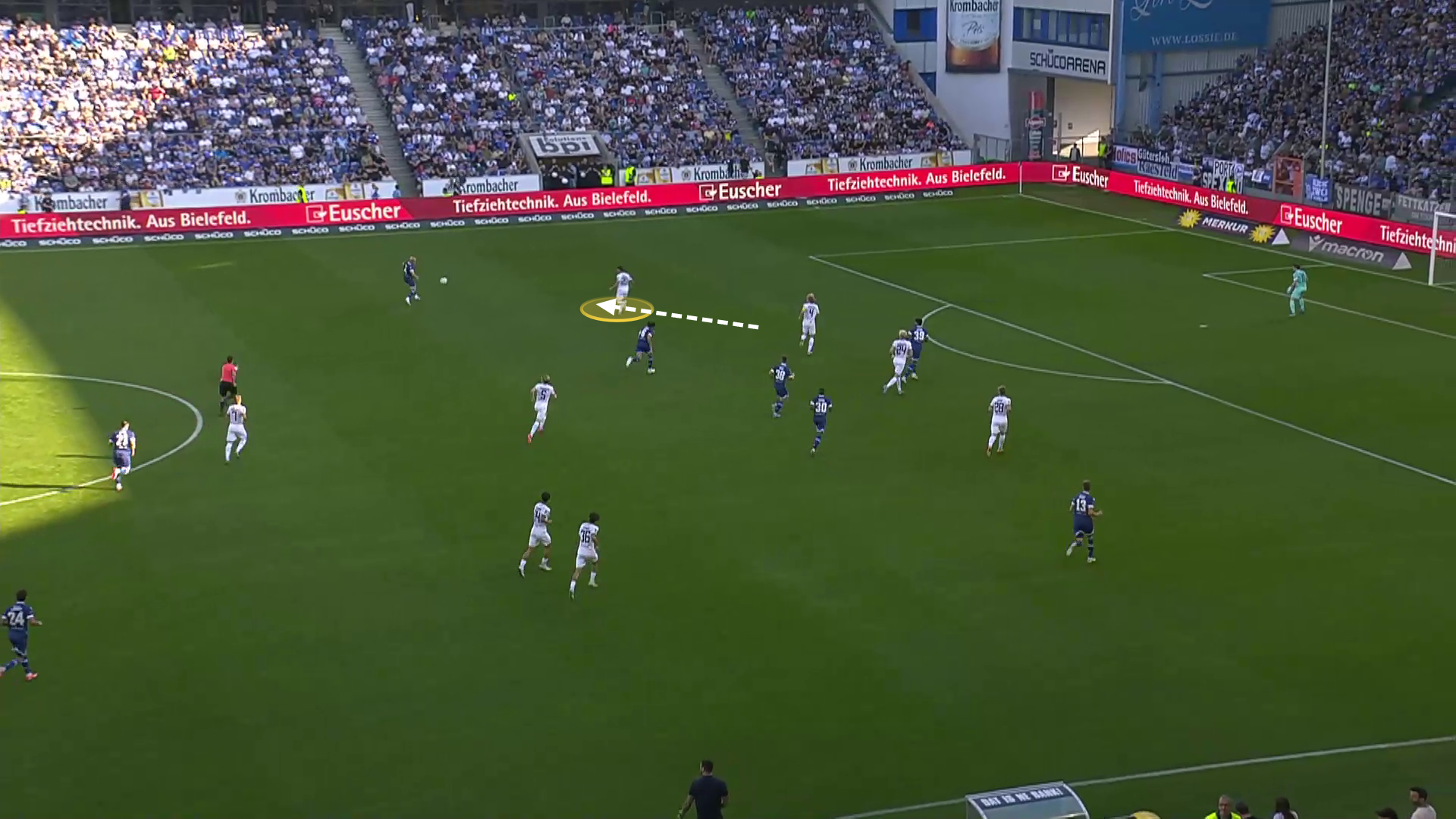
Here, we can see 1860 defending in a narrow shape.
Reich is playing as the right back and is also pushed inwards to cover the middle of the field instead of prioritising the wings, which 1860 does a lot.
When the switch is played to his side, Reich slowly positions himself for the resulting 1v1-duel on his side.
He scans the field while the ball is still in the air and realises he needs to stay patient because an additional attacker is running towards the gap between him and the right centre-back.
He stays calm and moves out slowly, covering the centre off and forcing an isolated situation on the wing.
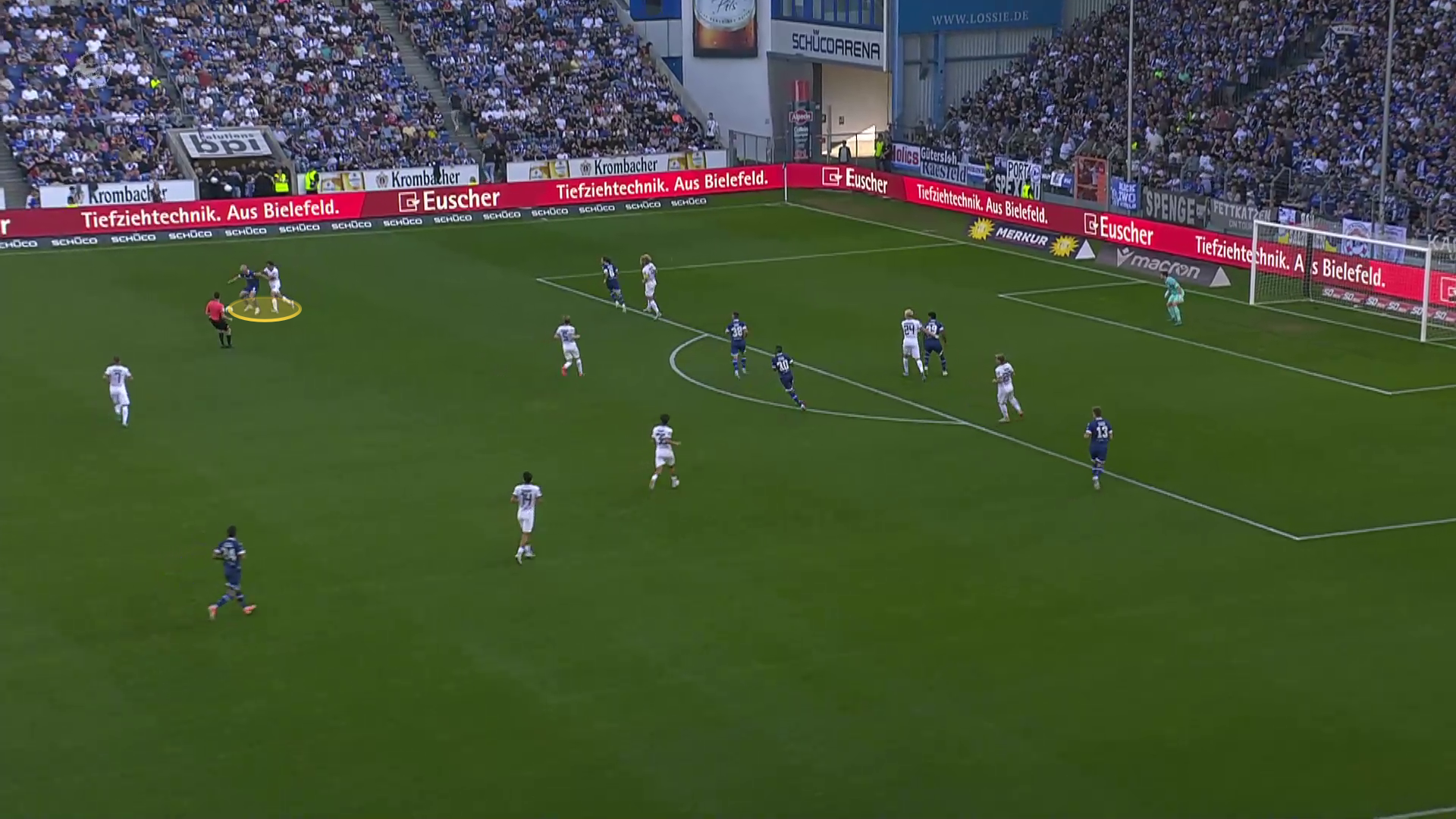
The attacker has a lousy touch in this situation, and Reich once again showcases his quick thinking.
The moment the attacker makes his mistake, Reich uses his good short-area quickness to instantly move forward and put some pressure onto the ball carrier.
He then managed to force the attacker to turn around and face his own goal again, stepping up in an even more aggressive way and forcing a backward pass, which ended the attack.
This just shows that Reich has elite positioning and an outstanding defensive football IQ.
While he could be more aggressive at times, it’s apparent that he knows he still has some limits at the professional level and, therefore, usually takes the safest option.
He does that exceptionally well, managing to cut off attacking options and defend very well.
He scans the field well and makes good decisions constantly.
He also doesn’t shy away from contact; he uses his body well in duels and tries to push attackers off the ball.
While he is physically impressive for a 17-year-old, he is not as strong as most professional players this season.
We can see this same form of decision-making a lot from Reich while defending.
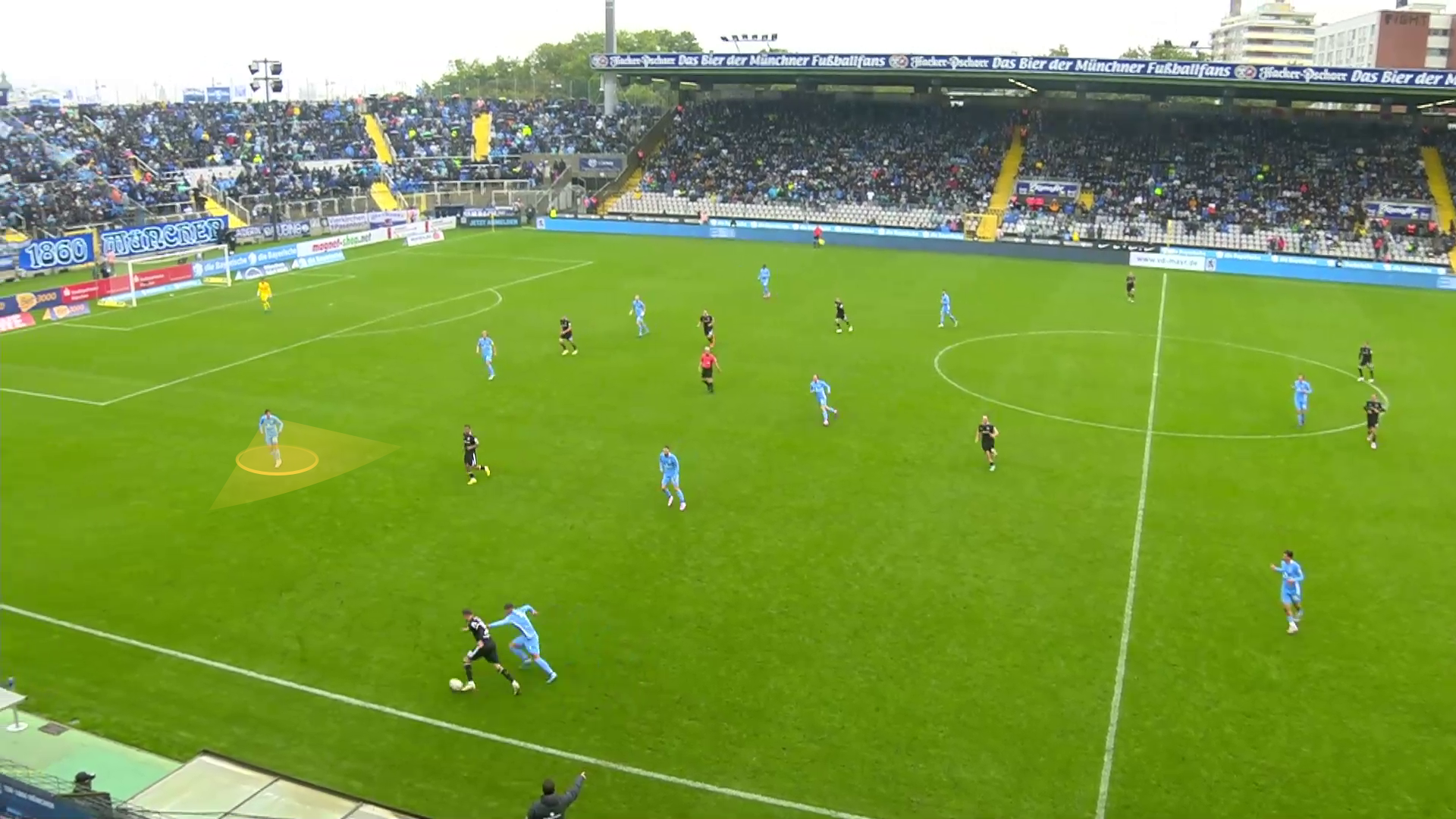
Here, we can see a near-sided attack in which the winger in front of him was relatively easily beaten by his man.
Reich still doesn’t panic and scans the field well again, realising that he can’t step up because of the attacker threatening the space behind him.
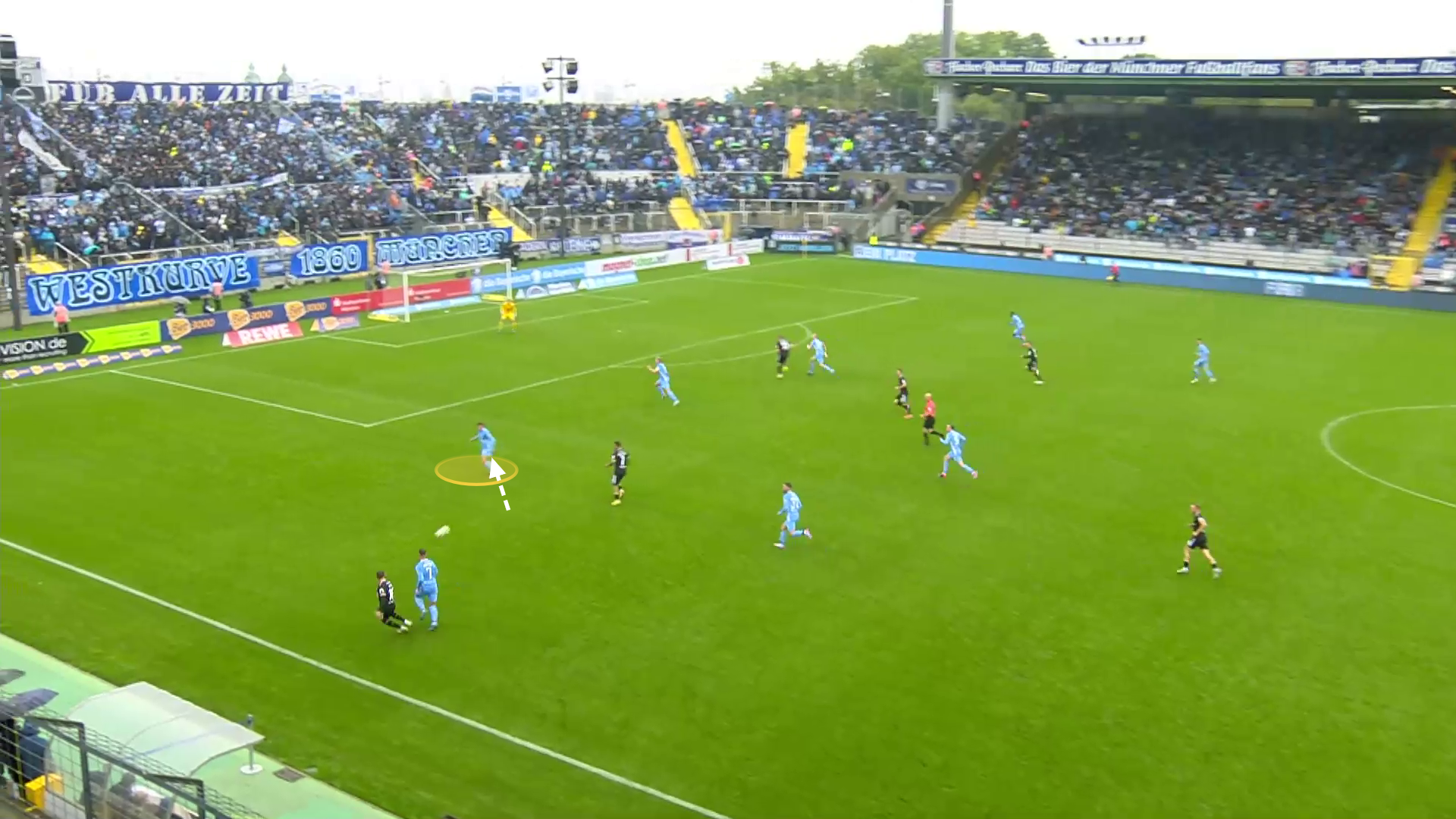
So he decides to focus on defending the centre again, letting his winger track back and move inwards to cut off the passing option to the box.
He checks over his shoulder well and realises the attacker is trying to receive between the lines.
Therefore, he stops dropping back and moves into the passing lane, getting the interception here and ending the attack.
This calm and quick decision-making and ease in applying the most basic principles of defence make Reich a better defender than the data suggests.
Lukas Reich Strengths
Now, after looking at a couple of patterns of play for Lukas Reich, let us examine what he has done well at his young age so far this season.
The first positive thing about his game is his off-the-ball attacking movement.
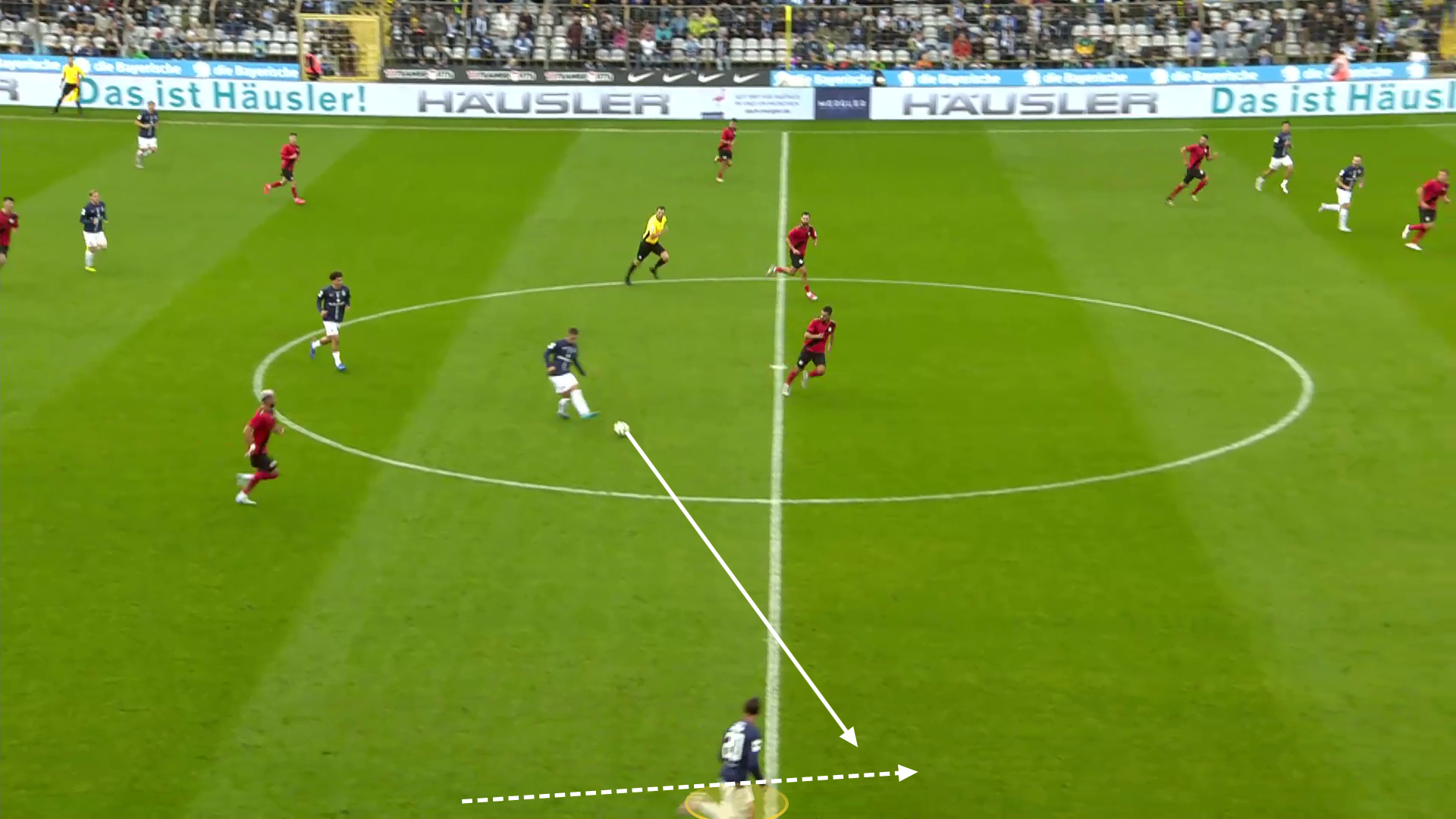
Here, we can see a situation in which 1860 was able to find an open midfielder and is trying to switch play to the right side.
Reich instantly moves forward and inside, moving into the space that Wiesbaden vacated in their attempt to press 1860.
Then, the usual attacking pattern happens again, and Reich can easily carry the ball forward, forcing the defenders to stay in a narrow shape and then play the pass outwards to his winger.
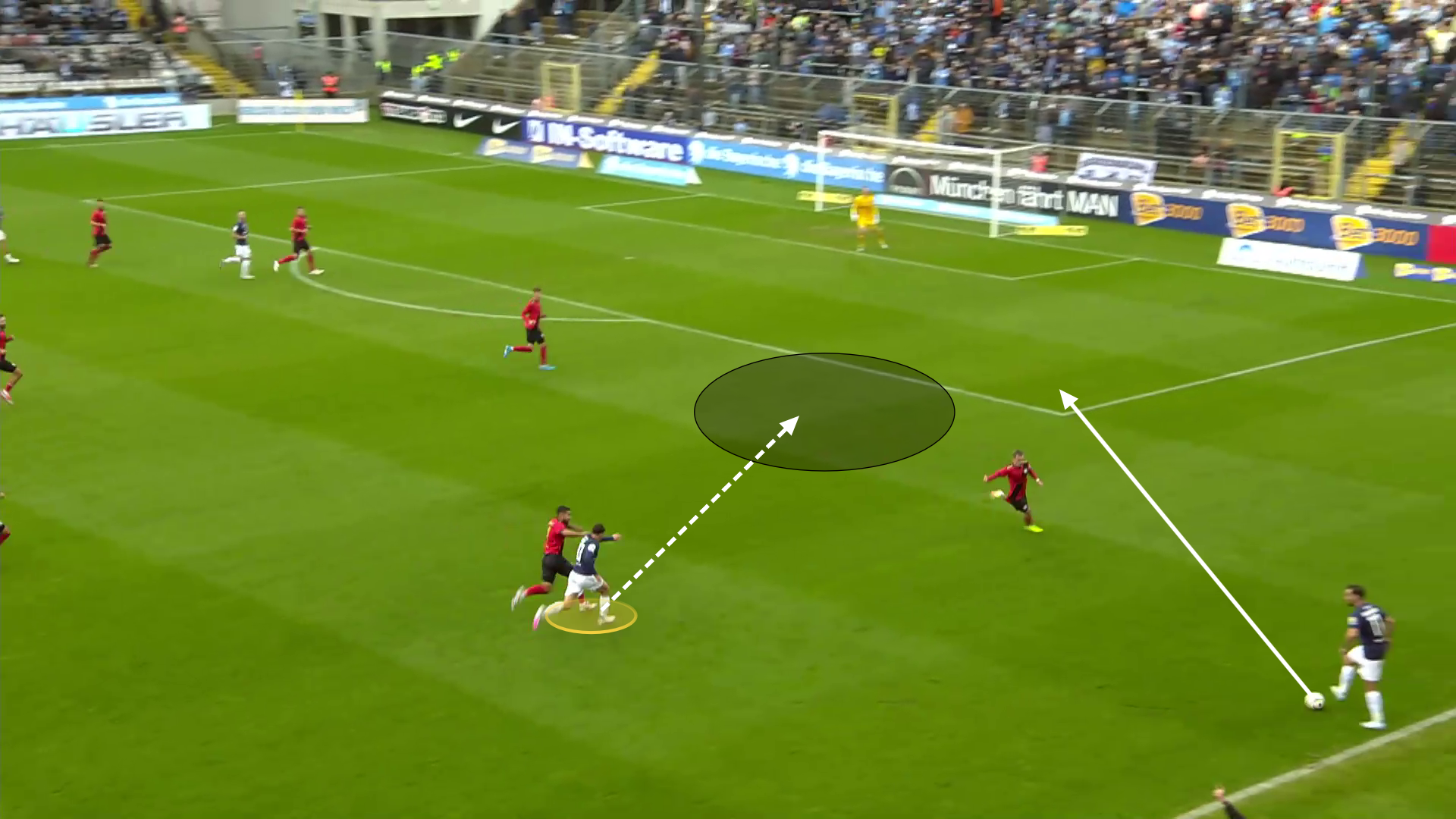
What Reich does great here, after he already positioned himself very well for the switch, is to keep moving forward.
The entire idea that 1860 uses while going forward heavily relies on players finding the open space they created by dragging defenders out of position and making runs into these areas.
Reich doesn’t hesitate one second after playing the pass and moves forward instantly, threatening the space that opened up behind the left-back and forcing the entire Wehen defence to scramble to regain control of the situation.
These types of runs are what make Reich such an excellent attacking right-back.
His timing and feel for open space are great, and he always puts himself on the front foot compared to defenders.
Another thing he does really well is defending in direct duels near the sideline.
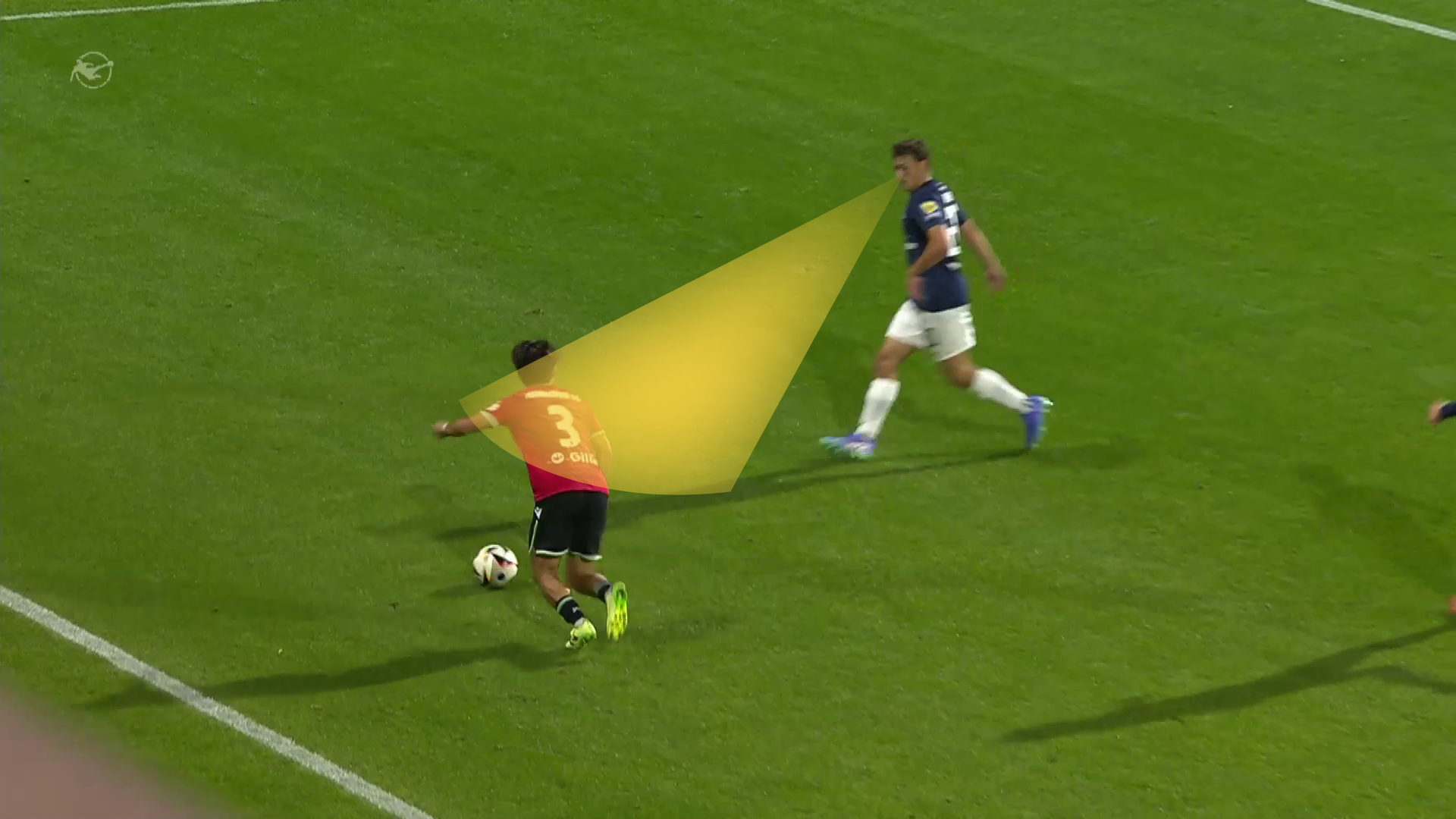
Here, we can see him in a defensive duel out on the wing.
He never takes his eyes off the ball after engaging in the duel and does not fall for the cross-fake the attackers are trying.
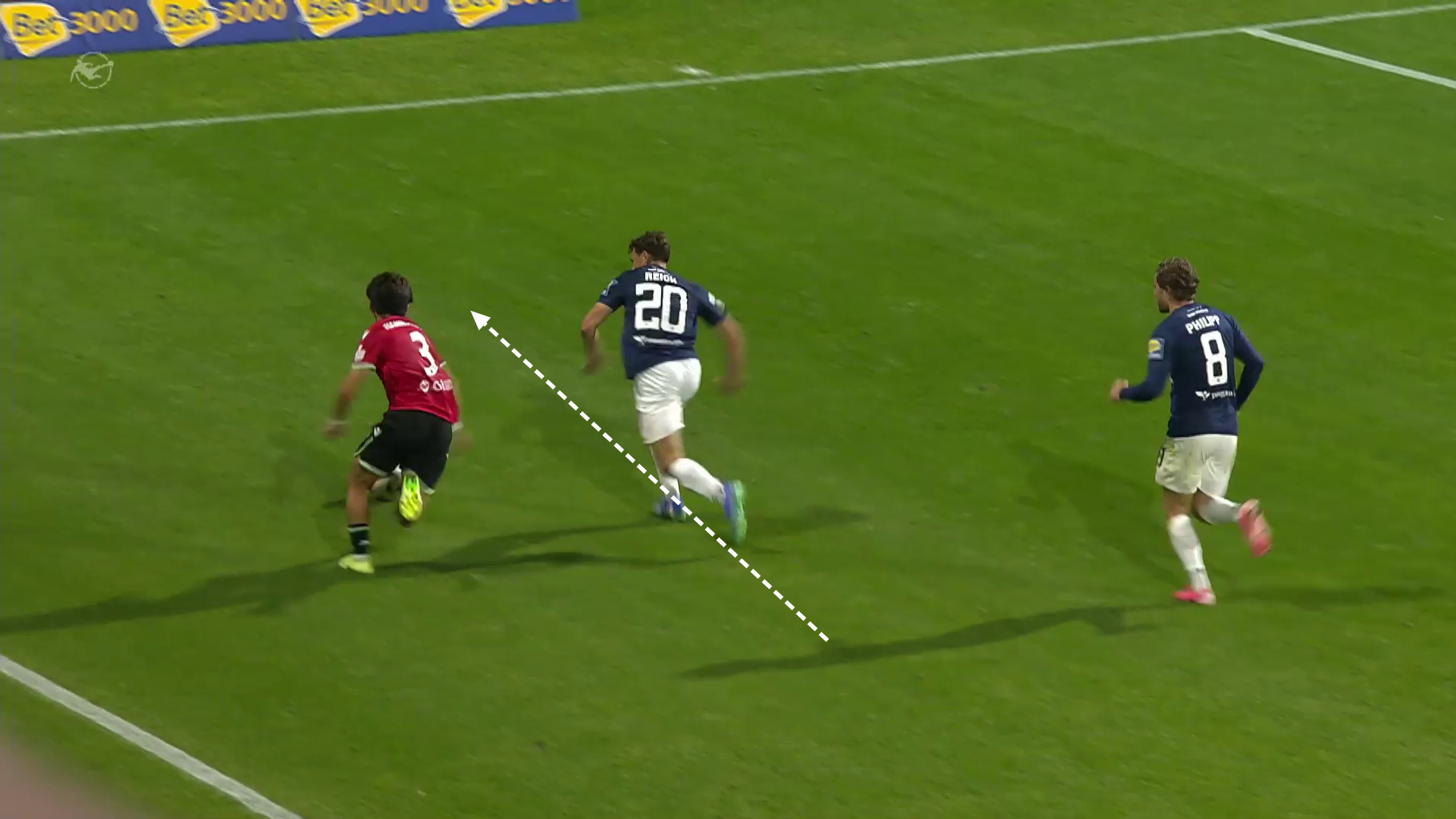
He then understands his teammates’ positioning well and cuts off the inside line, leaving him with less distance to cover.
While he might not be the fastest player in the position, he always makes up for it with clever things like this.
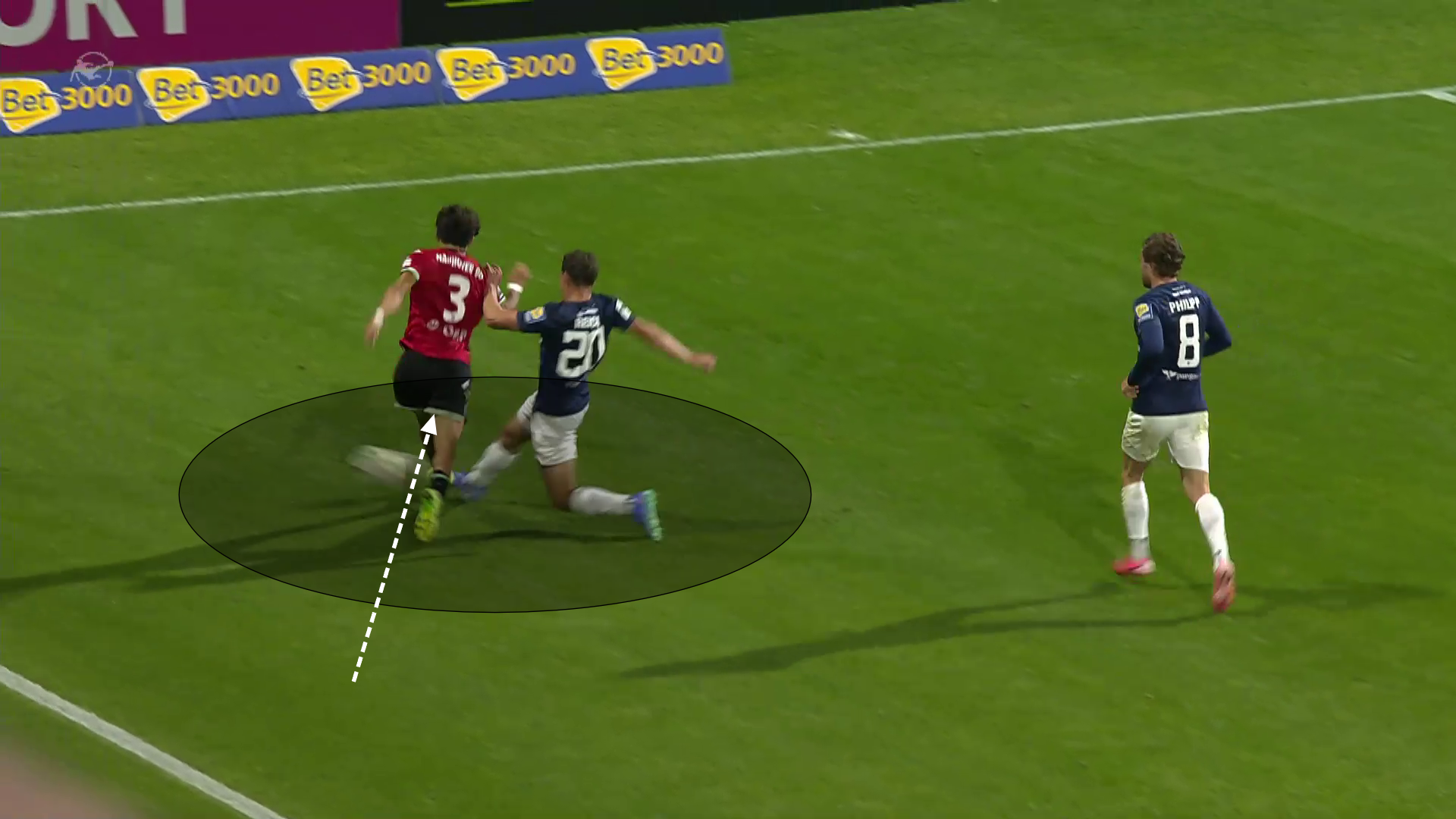
Obviously, the attacker then needs to start dribbling inside because he runs out of pitch in the corner.
Reich knows that and positions himself in a way where he gains leverage the moment the attacker cuts inside.
He then times his tackling perfectly when the dribbler is trying to get past him and easily wins the ball for his team, preventing a cross.
In these situations, Reich is rarely beaten and is very clever when defending a 17-year-old.
The last thing he does well is cover depth.
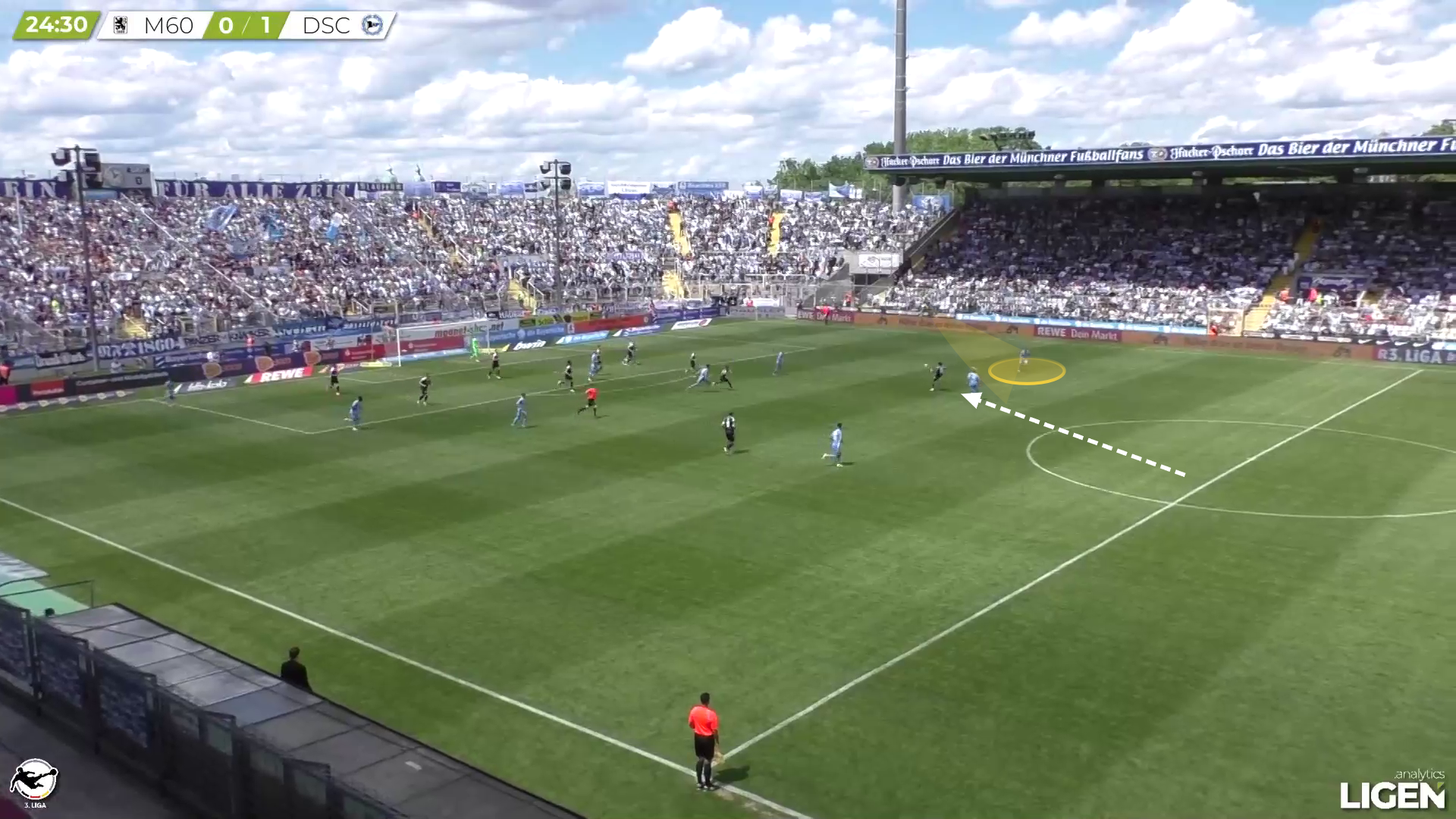
Here, we can see a counterattack against 1860 after a corner.
The central defender of the three-man rest defence is forced to step up with the striker.
Reich scans the field and realises that the middle of the field is wide open and that attackers are making a run for it.
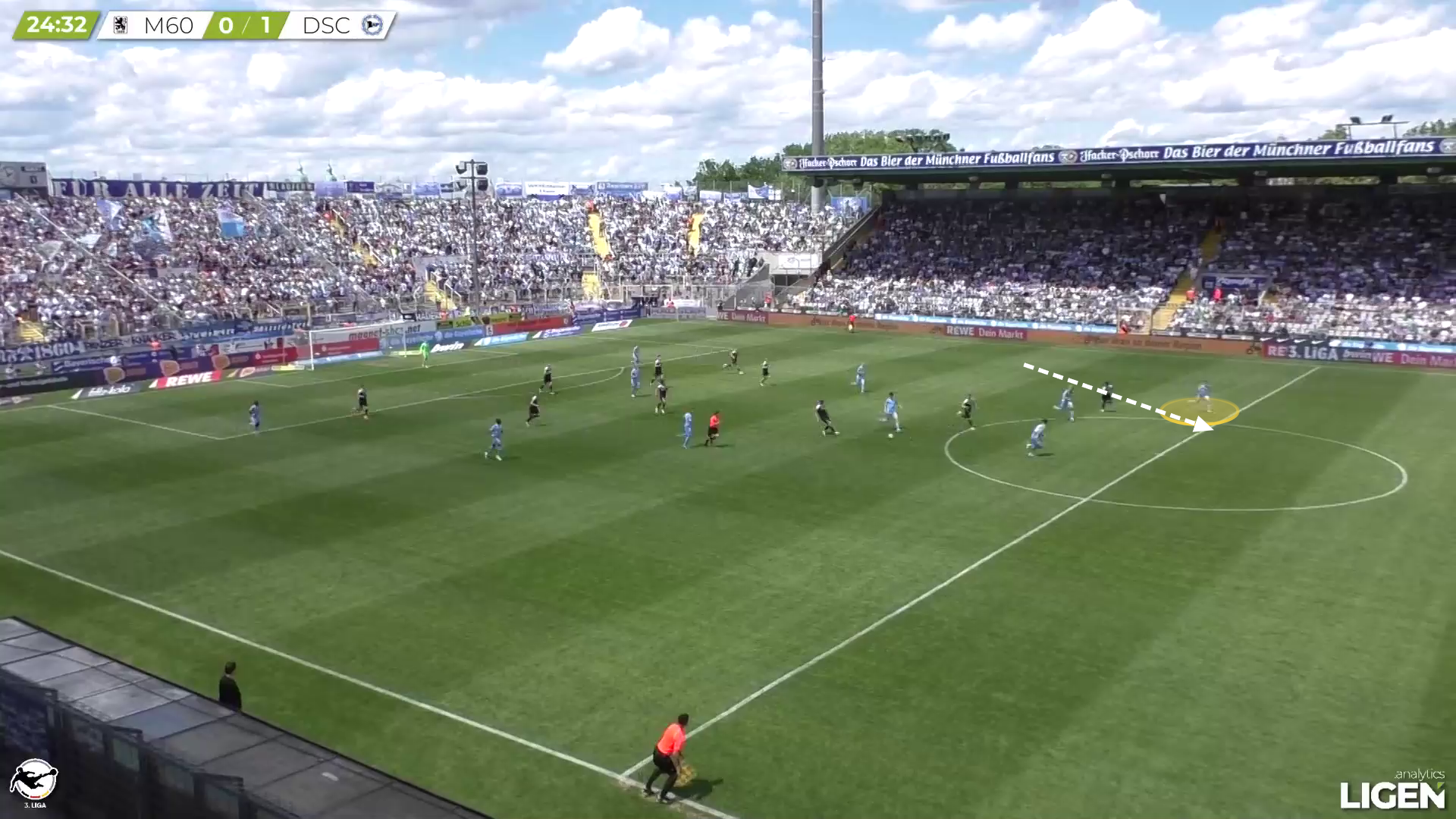
He then doesn’t just drop back; he drops back in a more central position and cuts off the passing lane and the run of the attacking player, preventing the deep ball from being played.
Again, Reich made a smart and quick decision to cover for his teammates’ overaggressive play.
Lukas Reich Weaknesses
In terms of weaknesses, Reich does not have much that he can’t do technically or tactically.
He is an excellent all-around player, and there isn’t something that stands out that other teams should be able to punish him right now.
There are a couple of things that still need to be addressed.
One thing and problem definitely is his pace.
While he is not slow, he still lacks a second gear while sprinting.
While he is able to match most of the wingers’ speed and gains leverage through his positioning, he is not fast, especially not over longer distances.
While the level of play in 3. Liga is decent; it is not a problem right now, but he needs to be careful with what he does once he reaches a level of play where wingers are able to punish these little things with ease.
Another problem is his attacking output right now.
While he creates a decent amount of xA and even xG and is one of only three right-backs that managed to collect a second assist so far in 3. Liga this season, he still has no goals and no assists on the scoresheet in professional games in his career.
His underlying stats are decent in these areas, and there is more than just hope that he can become more effective in the future.
As stated multiple times in this article, Reich is only 17 years old, so it is more than normal for him to struggle in some areas, especially in the box.
With more experience and game time, he should be able to improve to the point where it is no longer considered a weakness in his game.
Conclusion
It is always hard to judge the future development of players this young.
Still, considering what Lukas Reich brings to the table, it would be a massive surprise if he wouldn’t be playing in the Bundesliga sooner rather than later.
Germany have been struggling a lot over the last couple of years in this position.
This is not just at the highest level after Philipp Lahm retired. S
till, also overall — German academies have failed to produce high-level players at the full-back positions, especially right-back.
Reich is very impressive for his age, not just physically but also in terms of maturity and football IQ.
He defends very well and easily secures the most crucial areas on the pitch, consistently positioning himself well and preventing breakthroughs for the attacking teams.
He also showcased a lot of potential with the ball, creating a decent number of chances going forward, but he still lacks the final product there.
It will be interesting to see in what direction Reich will develop, but with an overall skill set that doesn’t lack any major thing, he should be able to do well for the rest of the season and then look to move to a better team, leaving his hometown behind.
This ‘jack-of-all-trades, master of none’ thing Reich has going on is very good for him right now, but it is also the one thing that could hold him back.
While there is still room for improvement everywhere in his game, even though he is at an impressive level for his age, his game also lacks a distinctive strength right now that could make him stand out at the next level.
Still, Lukas Reich is arguably the most talented full-back we have seen in the last 10 years in German football and will be able to grow into an excellent player over the next couple of years.
Will he fill the void that Lahm has left the national team with?
It’s too early to tell, but right now, he is a way better player than Lahm was at his age, and the rest is entirely up to Lukas Reich himself.

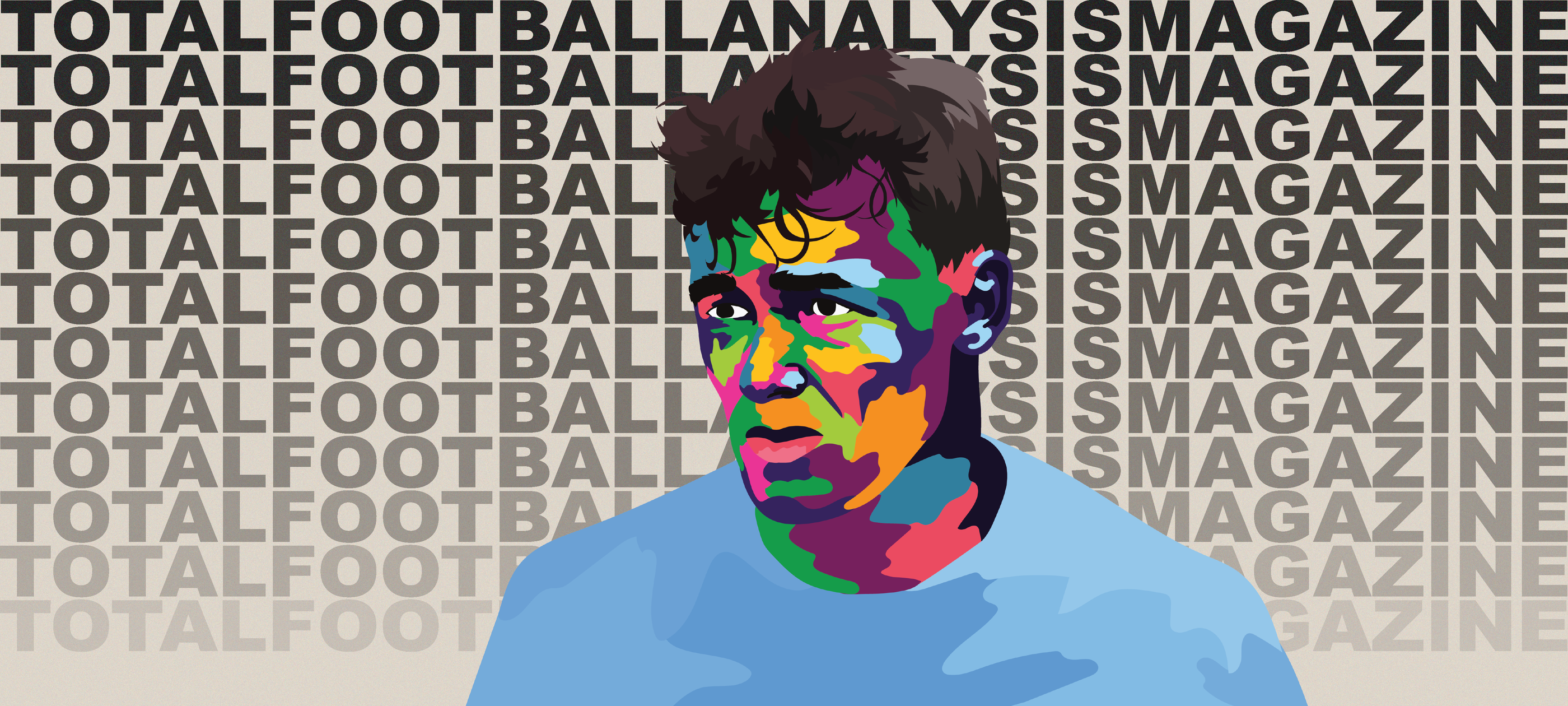




Comments